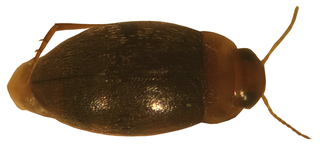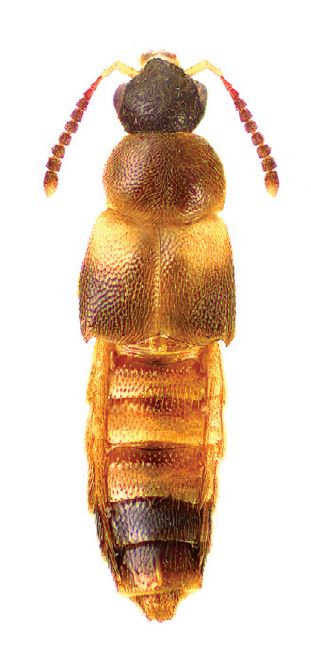Related Research Articles

The brown creeper, also known as the American treecreeper, is a small songbird, the only North American member of the treecreeper family Certhiidae.

Crataraea is a genus of rove beetles in the family Staphylinidae. There is at least one described species in Crataraea, C. suturalis.
Acalymma gouldi is a leaf beetle species in the genus Acalymma found in North America. It can be found on the foliage of Echinocystis lobata as well as Cucurbita and Cucumeris melo.

The Aleutian Islands, also called the Aleut Islands or Aleutic Islands and known before 1867 as the Catherine Archipelago, are a chain of 14 large volcanic islands and 55 smaller islands. Most of the Aleutian Islands belong to the U.S. state of Alaska, but some belong to the Russian federal subject of Kamchatka Krai. They form part of the Aleutian Arc in the Northern Pacific Ocean, occupying a land area of 6,821 sq mi (17,666 km2) and extending about 1,200 mi (1,900 km) westward from the Alaska Peninsula toward the Kamchatka Peninsula in Russia, and act as a border between the Bering Sea to the north and the Pacific Ocean to the south. Crossing longitude 180°, at which point east and west longitude end, the archipelago contains both the westernmost part of the United States by longitude and the easternmost by longitude. The westernmost U.S. island in real terms, however, is Attu Island, west of which runs the International Date Line. While nearly all the archipelago is part of Alaska and is usually considered as being in the "Alaskan Bush", at the extreme western end, the small, geologically related Commander Islands belong to Russia.

Phyllobius glaucus is a species of weevil found across Europe, especially in carrs. It is a pest of a variety of fruit trees, but has little economic effect. It was first described by Giovanni Antonio Scopoli in 1763.
Scolytus jacobsoni is an elm bark beetle occurring in forests of mixed broad-leaves with elm trees in Asia. In southeastern Russia, during years of outbreaks S. jacobsoni often attacks healthy trees along forest edges or standing alone along roads and in fields and gardens, making it an important pest for elm trees there. Reported hosts include Ulmus davidiana, Ulmus japonica, Ulmus laciniata, Ulmus propinqua, Carpinus betulus, and Pyrus ussuriensis.
Hydroporus subpubescens is a species in the family Dytiscidae, in the order Coleoptera ("beetles"). It is found in North America.
Agabetes acuductus is a species of predaceous diving beetle found in the United States and Canada. Its habitat includes wooded wetlands, in the leaf litter of shaded pools, and cattail ponds.
Agabus obliteratus is a species in the family Dytiscidae, in the order Coleoptera ("beetles"). It is found in North America.
Ilybius fraterculus is a species of predaceous diving beetles in the family Dytiscidae. It is found in North America.
Sanfilippodytes compertus is a species of predaceous diving beetles in the family Dytiscidae. It is found in North America.
Agabus ancillus is a species of predaceous diving beetles in the family Dytiscidae. It is found in North America.

Bidessonotus inconspicuus is a species of predaceous diving beetles in the family Dytiscidae. It is found in North America.

Drusilla is a genus of rove beetles in the family Staphylinidae. There are at least 2 described species in Drusilla.
Oreodytes scitulus is a species of predaceous diving beetle in the family Dytiscidae. It is found in North America.

Staphylinini is a tribe of large rove beetles in the family Staphylinidae. There are at least 20 genera and 120 described species in Staphylinini.

Graphoderus liberus is a species of predaceous diving beetle in the family Dytiscidae. It is found in North America.

Phymatura is a genus of rove beetles in the family Staphylinidae. There are at least 2 described species in Phymatura.
Altica woodsi is a species of flea beetle in the family Chrysomelidae. It is found in North America. It feeds on Vitis riparia and Virginia creeper.

Penthe obliquata, also known as the oblique polypore fungus beetle is a species of polypore fungus beetle in the family Tetratomidae. It is found in North America.
References
- ↑ Mordellidae Species List at Joel Hallan's Biology Catalog. Texas A&M University, archived from the original on 7 October 2014, retrieved 9 August 2015
- ↑ Webster, Reginald; Sweeney, Jon; DeMerchant, Ian (2012-04-04). "New Coleoptera records from New Brunswick, Canada: Mordellidae and Ripiphoridae". ZooKeys (179): 243–256. doi: 10.3897/zookeys.179.2583 . ISSN 1313-2970. PMC 3337063 . PMID 22539896.